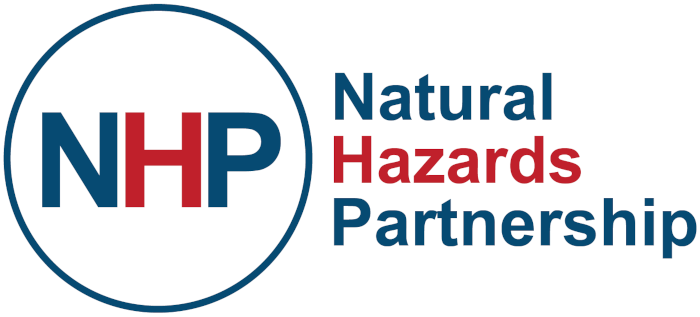The Natural Hazards Partnership (NHP)
Working in partnership to be ‘The UK’s trusted voice for coordinated natural hazards advice’.

The Met Office is actively involved in the Natural Hazards Partnership (NHP). We provide expertise in multiple natural hazards, contribute to the scientific development of hazard impact models and new joint research, and feed into the improvement and delivery of wide array of products and services that support the UK preparedness and response to natural hazards.
What is purpose of the Natural Hazards Partnership?
The purpose of the Natural Hazards Partnership (NHP) is to bring together the science and practitioner community across the natural hazard resilience space to improve readiness and response through scientific advancement and better coordination. The NHP operates horizontally across its partners and their end customers as well as vertically into government to support the Cabinet Office and GO-Science and other departments on various aspects of resilience work.
The NHP builds on the interdisciplinary expertise and in-kind support of its partners to deliver this coordinated natural hazards science, research and advice to Governments and Civil Contingency responders and other hazard resilience groups across the UK.
NHP Governance and Structure
The NHP is constituted as a consortium of government departments and agencies, trading funds, public sector research establishments and bodies, research council institutes and charities (see figure below for further details) which was established in 2011. The NHP Steering Group (NHPSG) sets the overall direction with coordination and delivery of the Operating Plan devolved to the Management Team. Delivery of science and services is led by the Natural Hazards Science to Services Group (HIS2G).

Above: Members of the Natural Hazards Partnership as of August 2024 - Met Office, National Centre for Atmospheric Research, National Oceanography Centre, National Environmental Research Council, Ordnance Survey, Network Rail, Natural Resources Wales, Scottish Environment Protection Agency, UK Space Agency, Cabinet Office, British Geological Survey, UK Centre for Ecology and Hydrology, UK Health Security Agency, British Red Cross, Department for Environment, Food and Rural Affairs, Department for Transport, England and Wales Wildfire Forum, Environment Agency, Government Office for Science, Welsh Government, Scottish Government and the Health and Safety Executive.
Why is the Natural Hazards Partnership useful?
Since its formation in 2011, the NHP has demonstrated the benefits that flow from a more coordinated approach across the resilience community to the delivery of improved natural hazard impact science and services, examples are:
- Improved natural hazards science and services coordination across UK public sector and non-government organisations.
- Better informed mitigation and adaptation strategies for individual natural hazards and for cascading and compounding hazards.
- Improved science-based risk assessments of hazard likelihood and potential impact.
- Improved warnings and advisory services for a range of natural hazards.
- Increased natural hazard data and visualisation interoperability.
- Providing expert advice to reviews of security and risks assessments at UK and Devolved Government level and supporting improved methodology.
- Being a catalyst for innovation across the natural hazards community.
- Convening the community to share knowledge and best practice.
These benefits are evidenced by the following achievements:
- NHP Daily Hazard Assessment (accessible through Met Office Hazard Manager, or more directly through email subscription for relevant agencies and organisations).
- The NHP Hazard Impact Framework (HIF) to support greater consistency of hazard impact assessments.
- Delivery of Hazard Impact Model (HIM) prototypes for vehicle over-turning in high winds and surface water flooding based on improved models of data interoperability.
- Expert advice, review and challenge of UK Governments’ natural hazard risk assessment processes e.g. NRSA 2023 and Scottish Risk Assessment 2023.
- NHP referenced as a model of international best practice by the UN International Strategy for Disaster Reduction (UNSDR), the World Meteorological Organisation (WMO) and European Commission (EC).
- Facilitated international collaborations to increase impact/reach of UK hazard research and brought learning back to the UK WCSSP.
- Development of links across the public, academic, third and private sectors e.g. Scottish Government sponsored National Centre for Resilience (NCR), and the British Red Cross (BRC), which is now a full NHP member.
What are the Natural Hazard Partnership’s practical outputs?
Since 2011 and following consultation with UK Governments and the responder community, the NHP has coordinated the development of a range of activities and outputs such as:
- Daily Hazard Assessment (DHA) since 2013, fully redesigned in 2024
- DHA Colour State Matrix
- Natural Hazard Science Notes
- Hazard Impact Modelling and Monitoring Frameworks
- Expert scientific input into the National Security Risk Assessments (NRSA)
- Hazard Overviews – one-page summaries for 11 hazards
- Hazard Infographics – single-slide summaries for 24 hazards
What is the Natural Hazard Partnership’s Focus?
Building on the progress already made and through a series of strategy workshops in 2018, the NHP concluded that the partnership can add most value by focussing on the preparation and planning elements and activities of the ‘Disaster Management Cycle’.

Above: NHP and the Disaster Management Cycle



